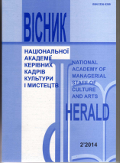WELL-KNOWN HISTORICAL EPISODE IN THE ART OF XXI C.: DISCOVERING, RE-THINKING, IDENTIFICATION
DOI:
https://doi.org/10.32461/2226-3209.2.2014.137980Keywords:
public art, historic battle and genres, cue interpretation, context, identityAbstract
The paper examines the artistic re-thinking of a real historical episode recreated in the art of past epochs, as a way for analyzing modern phenomena, on the basis of use and development of a plot of the famous painting by Diego Velázquez"The Surrender of Breda".
In summer 2013, the municipal mayor of Gandía (provinceofValencia,Spain) expressed the decision to remove the sculptural composition April 25, 1707, from the square under the same name. This composition created by the famous contemporary Catalan artist, Antoni Miró, and installed there in2007, inthe occasion of 300 anniversary of the battle of Almansa, represents a quotation from the well-know painting by Diego Velázquez "The Surrender of Breda" dedicated to other battle, at the Dutch city ofBreda(1625).
However, the objective of this article is not the investigation of rights and responsibilities of creators and customers of public artworks or the use of historical episode in the art, but re-thinking of previous artistic implementation of a certain episode from perspectives of time and successive experience. Or, speaking more exactly, the focus of this article is multi-figured historical painting by D. Velázquez "The Surrender of Breda" in modern art and culture, particularly, in the visual art of XXI c., using as example the creative work of Catalan painter and sculpture Antoni Miró (b.1944).
D. Velázquez created his canvas in 1634-35, nine years following the historical event presented at the painting which was ordered for the Sale of Realms in the Royal Palace of Buen Retiro. Thus, the main idea of the work was to glorify the power and arm of Spanish Empire ruled by Philipp IV. Digressing from standards and cannons of historical and battle painting of that time, Velázqueztried to demonstrate in a conventional episode of the keys of fortress handing sudden intimate dialogue between the conquerors and the defeated.
As the modern Lithuanian philosopher, Leonidas Donskis, writes in his book Power and Imagination, "In Velázquez’s nuanced and psychologically powerful painting, we see the triumphant Spanish grandees and the crushed and dejected Dutch officers. At the center of the painting, theBredacommander, Justin von Nassau, approaches the leader of the Spanish army, General Ambrogio Spinola, the scion of nobles fromGenoawho was famous for his courtly manners and gentlemanly behavior. Spinola does not glance at the keys to the fort being handed to him by the defeated commander vonNassau, but embraces the Dutch General’s shoulders and greets him as a friend. We know from historical accounts that Spinola thanked his defeated enemy for his bravery and called upon the Spanish army to behave toward the Dutch with the greatest possible respect. Spinola’s comportment reminds us of Don Quijote’s tavern speech wherein he defines a warrior’s code of conduct".
Antoni Miró, however, shares other point of view considering the well-known episode ofBredasurrender (see O. Butsenko. Antoni Miró. K.:1992 – p.215): "There is a known statement by the prominent poet Luis de Góngora, a contemporary of Velázquez: "Bredawas surrendered by hunger"… Documents testify, however, that when the Spaniards captured the fortress they found there stocks of grain sufficient for a month and of wine for three months". Thus, developing Velázquez’s topic in works of his series "Lances", A. Miró "emphasizes not the heroics of a historical incident but ordinary self-interest – mercenary opportunism (which, in fact, has always accompanied any war, great or small)". In one of the works, which preserves proportions and outlines of the original canvas, two hostile troops are already armed with missiles and tanks.
Who, eventually, is right – the Lithuanian thinker or the Catalan artist – in re-thinking the historical episode depicted by Velázquez? In principle, both have the reason since their approaches discover the same phenomenon, only from two contrary poles: "the relationship between political power and imagination during the transitional period when urope’s entire spiritual universe which we refer to as the world of the Middle Ages, became extinct… Not only did the ethics of chivalry vanish, but so did a code of conduct, a constellation of values, and a worldview…" and we become witness of "the birth of the world which we recognize as modernity" (L. Donskis. Power and Imagination, 69 p.).
Enlarging the time frames of Velázquez’s painting, up to 1707, when other battle, at Almansa, took place putting an end to Kingdom of Valencia as a legal and political entity, Miró has overthrew the well-know historical episode depicted by great Spanish painter. In the new context, the Velázquez’s glorification of Spanish power and invincibility turns out as the homage to courage of those who struggled for their right to independence – either on the level of the Dutch province of theValencianKingdom. And the demonstrative nobleness, justice and generosity, acceptable in the Middle Ages, become pure hypocrisy and fraud in our epoch under the power of, as Zygmunt. Bauman would say, the unholy trinity of modernity – uncertainty, unsafety, insecurity.
Downloads
Published
Issue
Section
License
Authors who publish with this journal agree to the following terms:
1. Authors retain copyright and grant the journal right of first publication with the work simultaneously licensed under a Creative Commons Attribution License that allows others to share the work with an acknowledgement of the work's authorship and initial publication in this journal.
2. Authors are able to enter into separate, additional contractual arrangements for the non-exclusive distribution of the journal's published version of the work (e.g., post it to an institutional repository or publish it in a book), with an acknowledgement of its initial publication in this journal.
3. Authors are permitted and encouraged to post their work online (e.g., in institutional repositories or on their website) prior to and during the submission process, as it can lead to productive exchanges, as well as earlier and greater citation of published work (See The Effect of Open Access).


